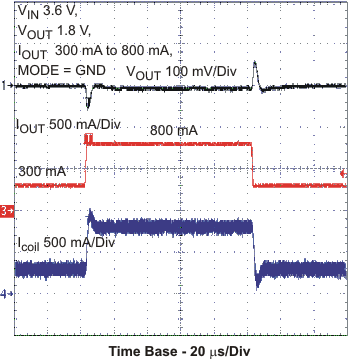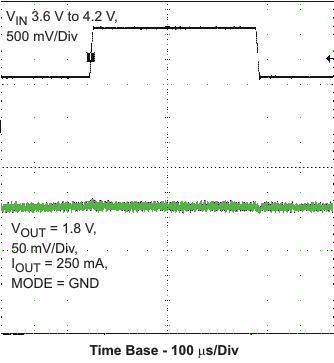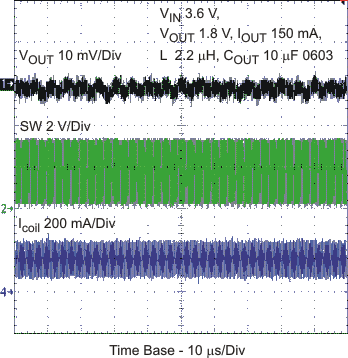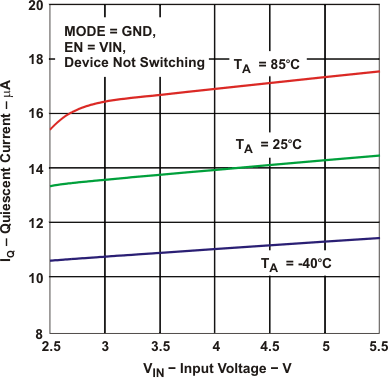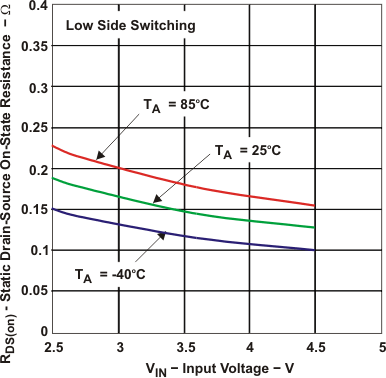SLVSAO5B December 2010 – October 2015 TPS62590-Q1
PRODUCTION DATA.
- 1 Features
- 2 Applications
- 3 Description
- 4 Revision History
- 5 Pin Configuration and Functions
- 6 Specifications
- 7 Parameter Measurement Information
- 8 Detailed Description
- 9 Application and Implementation
- 10Power Supply Recommendations
- 11Layout
- 12Device and Documentation Support
- 13Mechanical, Packaging, and Orderable Information
6 Specifications
6.1 Absolute Maximum Ratings
over operating free-air temperature range (unless otherwise noted)(1)| MIN | MAX | UNIT | |||
|---|---|---|---|---|---|
| VI | Input voltage(2) | –0.3 | 7 | V | |
| Voltage range at EN, MODE | –0.3 | VIN +0.3, ≤ 7 | V | ||
| Voltage on SW | –0.3 | 7 | V | ||
| Peak output current | Internally limited | A | |||
| TJ | Maximum operating junction temperature | –40 | 125 | °C | |
| Tstg | Storage temperature | –65 | 150 | °C | |
(1) Stresses beyond those listed under Absolute Maximum Ratings may cause permanent damage to the device. These are stress ratings only, which do not imply functional operation of the device at these or any other conditions beyond those indicated under Recommended Operating Conditions. Exposure to absolute-maximum-rated conditions for extended periods may affect device reliability.
(2) All voltage values are with respect to network ground terminal.
6.2 ESD Ratings
| VALUE | UNIT | ||||
|---|---|---|---|---|---|
| V(ESD) | Electrostatic discharge | Human-body model (HBM), per AEC Q100-002(1) | ±2000 | V | |
| Charged-device model (CDM), per AEC Q100-011 | ±1000 | ||||
(1) AEC Q100-002 indicates that HBM stressing shall be in accordance with the ANSI/ESDA/JEDEC JS-001 specification.
6.3 Recommended Operating Conditions
6.4 Thermal Information
| THERMAL METRIC(1)(2) | TPS62590-Q1 | UNIT | |
|---|---|---|---|
| DRV (SON) | |||
| 6 PINS | |||
| RθJA | Junction-to-ambient thermal resistance | 67.8 | °C/W |
| RθJC(top) | Junction-to-case (top) thermal resistance | 88.5 | °C/W |
| RθJB | Junction-to-board thermal resistance | 37.2 | °C/W |
| ψJT | Junction-to-top characterization parameter | 2 | °C/W |
| ψJB | Junction-to-board characterization parameter | 37.6 | °C/W |
| RθJC(bot) | Junction-to-case (bottom) thermal resistance | 7.9 | °C/W |
(1) For more information about traditional and new thermal metrics, see the Semiconductor and IC Package Thermal Metrics application report, SPRA953.
(2) Simulated values based on four layer FR4 board (2-oz, 1-oz, 1-oz, 2-oz copper) with size: 76 mm × 114 mm × 1.6 mm
6.5 Electrical Characteristics
Over full operating ambient temperature range, typical values are at TA = 25°C. Unless otherwise noted, specifications apply for condition VIN = EN = 3.6 V. External components CIN = 10 μF 0603, COUT = 10 μF 0603, L = 2.2 μH; see Parameter Measurement Information.| PARAMETER | TEST CONDITIONS | MIN | TYP | MAX | UNIT | |
|---|---|---|---|---|---|---|
| SUPPLY | ||||||
| VI | Input voltage range | 2.5 | 6 | V | ||
| IO | Output current(4) | VIN 2.7 V to 6 V | 1000 | mA | ||
| VIN 2.5 V to 2.7 V | 600 | |||||
| IQ | Operating quiescent current | IO = 0 mA, PFM mode enabled (MODE = GND) device not switching, See (1) |
15 | μA | ||
| IO = 0 mA, switching with no load (MODE = VIN) PWM mode, VO = 1.8 V, VIN = 3 V |
3.8 | mA | ||||
| ISD | Shutdown current | EN = GND | 0.5 | μA | ||
| UVLO | Undervoltage lockout threshold | Falling | 1.85 | V | ||
| Rising | 1.95 | |||||
| ENABLE, MODE | ||||||
| VIH | High-level input voltage, EN, MODE | 2.5 V ≤ VIN ≤ 6 V | 1 | VIN | V | |
| VIL | Low-level input voltage, EN, MODE | 2.5 V ≤ VIN ≤ 6 V | 0 | 0.4 | V | |
| II | Input bias current, EN, MODE | EN, MODE = GND or VIN | 0.01 | 1 | μA | |
| POWER SWITCH | ||||||
| rDS(on) | High-side MOSFET on-resistance | VIN = VGS = 3.6 V, TA = 25°C | 250 | mΩ | ||
| Low-side MOSFET on-resistance | 190 | |||||
| ILIMF | Forward current limit MOSFET high-side and low-side | VIN = VGS = 3.6 V, TA = 25°C | 1.19 | 1.4 | 1.78 | A |
| TSD | Thermal shutdown | Increasing junction temperature | 140 | °C | ||
| Thermal shutdown hysteresis | Decreasing junction temperature | 20 | ||||
| OSCILLATOR | ||||||
| fSW | Oscillator frequency | 2.5 V ≤ VIN ≤ 6 V | 2.25 | MHz | ||
| OUTPUT | ||||||
| VO | Adjustable output voltage range | 0.75 | VI | V | ||
| Vref | Reference voltage | 600 | mV | |||
| VFB(PWM) | Feedback voltage | MODE = VIN, PWM mode, 2.5 V ≤ VIN ≤ 6 V, See (2) |
–2.5% | 0% | 2.5% | |
| VFB(PFM) | Feedback voltage, PFM mode | MODE = GND, device in PFM mode, 1% voltage positioning active, See (1) | 1% | |||
| Load regulation | –1 | %/A | ||||
| tStart Up | Start-up time | Time from active EN to reach 95% of VO | 500 | μs | ||
| tRamp | VO ramp-up time | Time to ramp from 5% to 95% of VO | 250 | μs | ||
| Ilkg | Leakage current into SW pin | VI = 3.6 V, VI = VO = VSW, EN = GND, See (3) |
0.1 | 1 | μA | |
(1) In PFM mode, the internal reference voltage is set to typ. 1.01 × Vref . See Parameter Measurement Information.
(2) For VIN = VO + 1 V
(3) In fixed output-voltage versions, the internal resistor divider network is disconnected from the FB pin.
(4) Not production tested.
6.6 Typical Characteristics
Table 1. Table Of Graphs
| FIGURE | ||
|---|---|---|
| Efficiency | vs Output Current VOUT = 1.8 V (Power-Save Mode) | Figure 1 |
| vs Output Current VOUT = 1.8 V (Forced PWM Mode) | Figure 2 | |
| vs Output Current VOUT = 3.3 V (Power-Save Mode) | Figure 3 | |
| vs Output Current VOUT = 3.3 V (Forced PWM Mode) | Figure 4 | |
| Output Voltage | vs Output Current VOUT = 1.8 V (Forced PWM Mode) | Figure 5 |
| vs Output Current VOUT = 1.8 V (Power-Save Mode) | Figure 6 | |
| vs Output Current VOUT = 3.3 V (Forced PWM Mode) | Figure 7 | |
| vs Output Current VOUT = 3.3 V (Power-Save Mode) | Figure 8 | |
| Transient Behavior | PFM to PWM to PFM Load Transient | Figure 9 |
| PWM Load Transient | Figure 10 | |
| PFM Line Transient | Figure 11 | |
| PWM Line Transient | Figure 12 | |
| Typical Performance – PFM Mode | Figure 13 | |
| Typical Performance – PWM Mode | Figure 14 | |
| Shutdown Current | into VIN vs. Input Voltage | Figure 15 |
| Quiescent Current | vs Input Voltage | Figure 16 |
| Static Drain-Source On-State Resistance | vs Input Voltage | Figure 17 |
| Figure 18 | ||
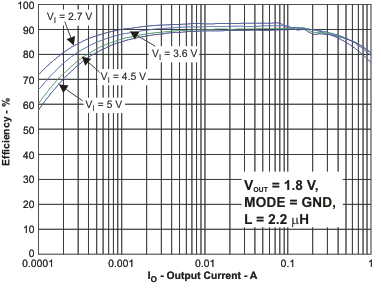
VOUT = 1.8 V (Power-Save Mode)
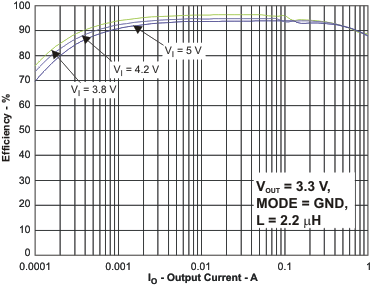
for VOUT = 3.3 V (Power-Save Mode)
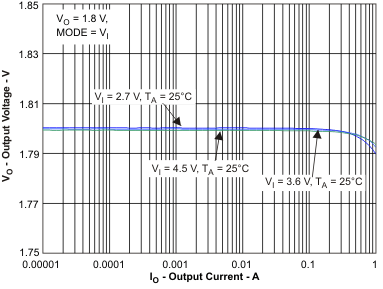
vs Input Voltage for VOUT = 1.8 V (Power Saver Mode)
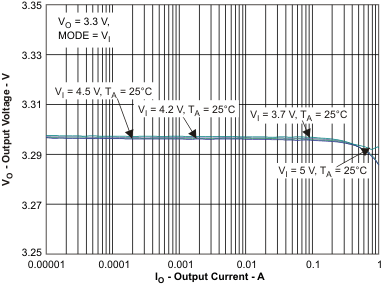
vs Input Voltage for VOUT = 3.3 V (Forced PWM Mode)
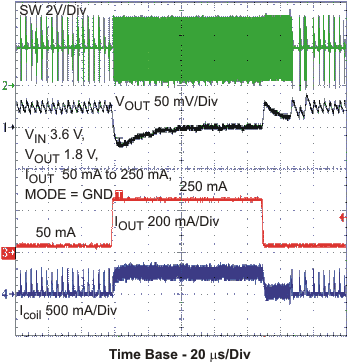
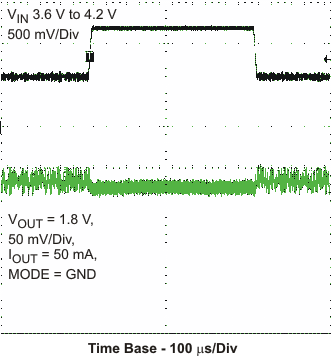
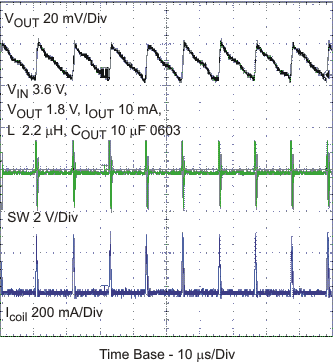
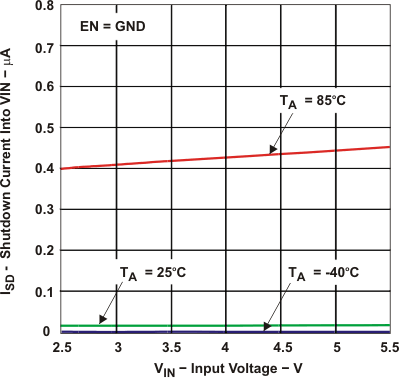
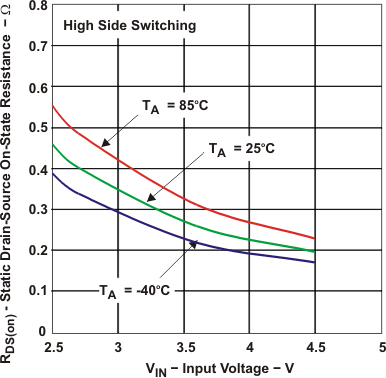
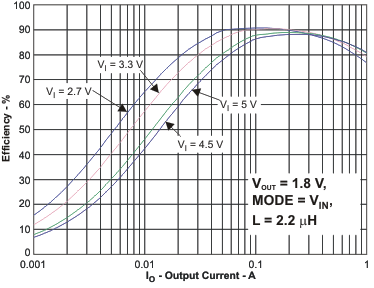
for VOUT = 1.8 V (Forced PWM Mode)
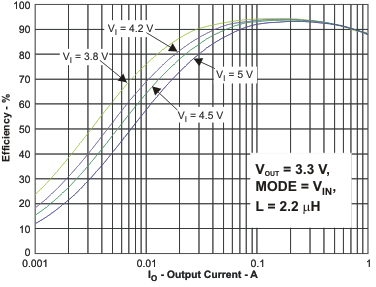
for VOUT = 3.3 V (Forced PWM Mode)
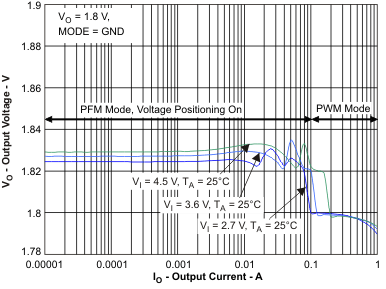
vs Input Voltage for VOUT = 1.8 V (Forced PWM Mode)
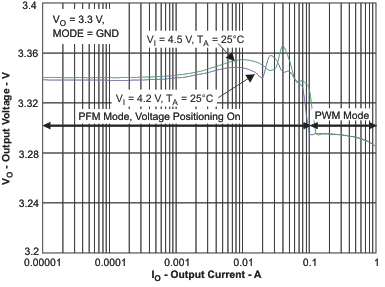
vs Input Voltage for VOUT = 3.3 V (Power Saver Mode)
